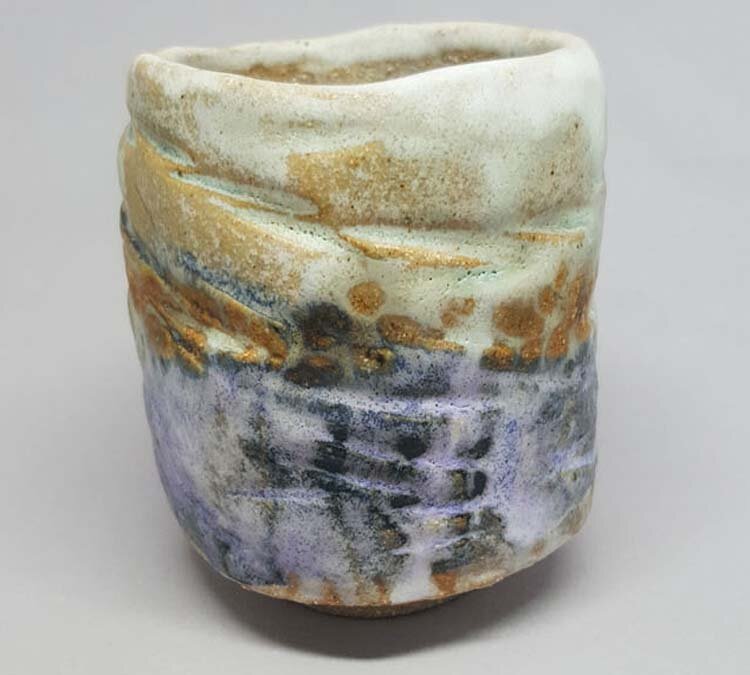to begin at the beginning
my work
Ewen Henderson described clay as ‘fluxed earth’*, the product of the forces of water and weather on rock - an organic, plastic and infinitely flexible material. All these qualities determine how my work should look and feel - the shapes, the textures, colours and finishes. I love the contrast of the smooth precision of porcelain against the craggy textures of earthy crank, the shiny waxy sensuousness of glaze against the rough ruggedness of a dry oxide on unglazed clay.
Much of my current work is hand-built. I enjoy the demands of throwing on the wheel but there is a freedom of expression in forming by hand which is sometimes lacking in wheel-thrown work. In their different ways each way of working is a meditative exercise. Being a practical sort of person I want what I make to be functional and useful, as well as good to look at and to demand to be picked up and touched. However delicate the porcelain bowl, however rugged the clay vessel, they should feel satisfying in the hand and true to their materials.
I often mix my own stoneware and porcelain body clays to match what I am working on and all my glazes are my own recipes. One of the great joys of opening the kiln when it is completely cold after a glaze firing is to discover a new and beautiful or interesting surface. The kiln will work its own influence and there are often surprising results. There is science to firing, but also a lot of luck, as well as trial and error, in testing new bodies, glazes and finishes. This is a time consuming, fascinating and yes, sometimes frustrating, occupation - but always worthwhile.
Modern mass produced ware has its place and some is well designed and pleasing to look at, but no manufactured ware can beat the feel of a handmade piece or its connection with the hand, eye and intention of its maker.
inspiration
I was brought up on the beaches of the North East of England – its wild ruggedness, pristine sands and sometimes gloriously hot summers. We spent lifetimes collecting shells and pebbles, exploring rockpools, watching sea creatures, and gathering seaweed and other flotsam and jetsam which threw up on the sand. The wild winter sea around Marsden rocks, covered in sea birds and lashed by wind and rain are an abiding memory. I loved it when it was wild and stormy, and I loved it calm and warm and soothing.
My mother was from a mining family in the North East of England. From the beginning she taught me to make - with fabric, thread, wool and any materials which came to hand - so I became a maker. My grandfather was a talented amateur painter, and my grandmother the strong centre who had been active in women’s suffrage. We loved to spend every school holiday with them, my sister and I sleeping head to toe in the tiny box room filled with his paints and work in progress. His favourite subject was The North Sea and its coastline. Inevitably, those early happy times are an important influence on my work.
Another influence is that of traditional Japanese and Korean ceramics. This has been a strong thread in British studio pottery since Bernard Leach introduced it to the UK in the 1920s. But my interest in all things Japanese also grew from exposure to Japan and its culture as a child. My father had been stationed there and brought back a collection of artefacts, photographs and paintings which sparked my lifelong fascination with traditional Japanese craft.
where did it all start with clay?
I have been many things in my life, but in my head I have always been a potter. I fell in love with clay at school and I know that I was very fortunate. The indomitable Peggy Angus ran the art department and made sure that it was taken seriously as a subject - our teachers included people like Ewen Henderson and Moy Keightley. Clay became a lifetime passion, but the idea that a girl could earn a living from art, especially ceramics, at that time seemed a pipe dream. Inevitably, like many of my peers, I opted for a ‘sensible’ degree to earn a living.
Years later, returning to the UK after working abroad, I took a City & Guilds diploma course in ceramics through Guildhall University in London, set up a studio in SW London, sold work and even had an exhibition at a small gallery in St James. But London life still managed to get in the way and the sensible option ruled. I was determined to return to ceramics as soon as I could and now that we’ve moved out of London I have my studio at home and I can finally concentrate on what I love doing most.
*Sotheby’s 24/7/2018 – Pioneer of Clay: Sculptor Ewen Henderson

